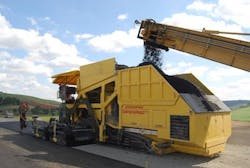Paving Report: New Technology Places Two Lifts Simultaneously
Based on the success of Dynapac’s Compactasphalt road-paving technology in Germany, the concept is on its way to North America for demonstration this summer. Compactasphalt technology allows the simultaneous placement of two hot-mix lifts, typically a binder course and a wearing course, resulting in single-pass, hot-on-hot mats as thick as 11.8 inches. According to Dynapac, European experience with the process has shown reduced construction times of up to 50 percent and the prospect of prolonged durability of the wearing course—perhaps up to 25 years.
At the heart of the process, says Dynapac, is its DF145CS paver fitted with the CM2500 hopper/screed module. So equipped, the paver has two material hoppers and two screeds that are simultaneously in use. The first screed applies a highly compacted binder course, and the second places a wearing course directly behind, without the need to spray a bitumen emulsion on the binder course prior to applying the wearing course.
The front screed is a high-compaction unit—with tampers, vibration and a final compaction unit (pressure plate)—that establishes an optimally compacted binder course. This screed can be raised and deactivated for structures, such as bridge decks, where no binder course is required. A standard Dynapac tamping, vibrating screed applies the wearing course. This screed is positioned directly behind the front high-compaction screed. Surface profile and slope for both screeds can be synchronized from one display to simplify adjustment.
The intense interlocking of courses eliminates the need to compact the binder course, says the company, and uniform course thicknesses are achieved through the synchronization of slope and surface profiles for both screeds. A roller with low linear load is recommended for initial compaction of the wearing course. Dynapac also makes the point that the thicker combined mats hold heat longer, allowing more time for compaction, even in cooler weather.
The funnel-shaped, 31-ton-capacity front hopper, which holds the binder material, is designed for uniform emptying without segregation. The 17-ton-capacity upper hopper holds wearing-course material. Compared with conventional paving methods, says Dynapac, wearing-course thickness can be significantly reduced, potentially providing material savings without affecting mat quality.
To accommodate the CM2500 hopper/screed module, the DF145CS incorporates various modifications and reinforcements, plus special control units. According to Dynapac, the drive mechanism for the module is located at the front, serving as a counterweight for optimum balance and, by its location, making more space for the wearing-material hopper. The DF145CS can be used without the CM2500 module for conventional road paving, or several pavers can share the same module. The conversion process typically requires about four hours.
For conventional paving, says Dynapac, screeds with gas heating can be used for working widths up to 44 feet; with the Compactasphalt process, working widths of up to 25 feet are achievable. A patented “excenter” adjustment lever is designed to enable the screed to be set quickly to the top, binder or base course.
According to Dynapac, the Compactasphalt process also results in a significant reduction of carbon-dioxide emissions, since the need to mill and repave roadways is reduced during the pavement’s life cycle, compared with pavements placed via conventional means.
